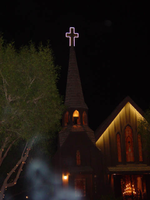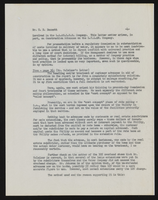Search the Special Collections and Archives Portal
Search Results
C. C. Mobley Photograph Collection
Identifier
Abstract
The C. C. (Clio Cline) Mobley Photograph Collection (approximately 1911 to 1917) consists of sixteen black-and-white photographic prints with corresponding photographic negatives. The images depict the Las Vegas, Nevada Ranch while the Mobley family leased it from the Union Pacific Railroad during the period. The photographs depict the home, swimming pool, the Old Las Vegas Mormon Fort, and orchards and streams on the property.
Archival Collection
Las Vegas Bugle Collection on Lesbian, Gay, Bisexual, and Transgender History
Identifier
Abstract
The
Archival Collection
Daly v. Daly Collection
Identifier
Abstract
The Daly v Daly Collection documents materials produced for and as a result of the lawsuits between Suzanne Daly (formerly Tim Daly), a male-to-female transgender woman, and Nancy Toews Daly from 1980 to 2003. The collection primarily focuses on the motions filed with the Nevada District Courts and Nevada Supreme Court and transcripts of the divorce, the battle for parental rights, and an allegation of civil rights violations.
Archival Collection
Tony Costa Sheet Music and Music Scores
Identifier
Abstract
The Tony Costa Sheet Music and Music Scores (1936-1995) consists of printed sheet music and hand-written scores composed by entertainer, songwriter, and Las Vegas, Nevada orchestra conductor Tony Costa.
Archival Collection
Evelyn Stuckey Papers
Identifier
Abstract
The Evelyn Stuckey Papers date from 1940 to 1972 and document Stuckey's experience as a physical education teacher at Las Vegas High School (LVHS) in Las Vegas, Nevada and founder of the LVHS Rhythmettes dance group. The collection contains personal and educational materials from Stuckey’s college years, personal correspondence, and photographs. It also contains materials documenting the Rhythmettes' activities including travel plans, posters and fliers, news clippings, and group rosters.
Archival Collection
Las Vegas Professional Sports Teams Collection
Identifier
Abstract
The Las Vegas Professional Sports Teams Collection (1988-2008) consists of brochures, ephemera, and programs from various Las Vegas, Nevada sports teams. Teams include the Coyotes, Dustdevils, Flash, Thunder, Silver Streaks, and Wranglers. The sports include basketball, ice hockey, inline hockey and indoor soccer.
Archival Collection
State of Arizona vs. State of California Proceedings Concerning the Colorado River Usage Dispute
Identifier
Abstract
The State of Arizona vs. State of California Proceedings Concerning the Colorado River Usage Dispute collection (1957-1961) contains supplemental documents from the
Archival Collection
UNLV Libraries Collection of Scientific Games Holding Corporation Financial Reports and Press Materials
Identifier
Abstract
The UNLV Libraries Collection of Scientific Games Holding Corporation Financial Reports and Press Materials contains financial reports, equity research reports, Securities Exchange Commission Form 10-K, Securities Exchange Commission Form 10-Q, prospectus, press kits, and press releases from Scientific Games Holding Corporation, an instant lottery ticket manufacturer based in Alpharetta, Georgia. The records date from 1993 to 2006.
Archival Collection

Photographs of Little Church of the West signs, Las Vegas (Nev.), 2002
Date
Archival Collection
Description
Site name: Little Church of the West
Site address: 4617 S Las Vegas Blvd
Sign owner: Greg Smith
Sign details: The Little Church of the West now resides on the south end of the Strip, along the east side among the smaller roadside hotels. Surrounded with pleasant landscaping the property is a charming and welcome sight among the more barren area of the strip.
Sign condition: Structure 4 Surface 4 Lighting 5
Sign form: Pylon; Fascia
Sign-specific description: There are two specific signs which are significant to the property. The first being the double backed internally lit pylon roadside sign which sits on the east side of Las Vegas Blvd and faces east/west. The 10 feet at its widest, and thirty seven feet tall. The structure consists of a center pole upon which an internally lit plastic sculpted message board sits. Painted in an old west script upon the plastic are the words "Little Church Of The West Wedding Chapel," with painted scrollwork on the top and the bottom of the plane. The entire message board is bordered in neon. Sitting on top of the message cabinet is a small, sculpted apse and bell. The original sign from its original construction still exists atop the actual structure of the Little Church of the West. It is an image of a cross outlined in white neon.
Sign - type of display: Neon; Backlit
Sign - media: Steel; Plastic
Sign - non-neon treatments: Graphics; Paint
Sign animation: none
Sign environment: The property sits among the dying roadside motel environment of the South end of Las Vegas Blvd It stands as on of the properties that is still in good repair. The pleasant landscaping and grass provide a pleasant establishment among the southern strip. It seems to capture the environment it has always tried to attain, of the picturesque country church.
Sign manufacturer: Larsen Sign
Sign - date of installation: It was originally part of William J. Moore's Last Frontier Village, which was assembled in the late 1950's. The current pylon sign was manufactured in 1996.
Sign - date of redesign/move: Originally, it resided in the Las Frontier until it was demolished in 1954. The Little Church of the West stood approximately in the spot where Sax Fifth Avenue is located. When the New Frontier was constructed, it was moved to the east side of the Strip approximately where the Silver Slipper was located. It stood in this location until 1978 when it was moved to the south edge of the Hacienda's property. The property was moved to its current location in 1996.
Sign - thematic influences: The thematic influence of the Little Church of the West draws from its original property which was the Old Western theme of the Frontier Hotel Casino. The Last Frontier Village was assembled from actual Western towns and reassembled on the Last Frontier's Property. With its wooden facade, brown color tones, script and pylon structure, the Little Church of the West rings true with its origins, while still incorporating the subtle elements of Las Vegas such as neon.
Sign - artistic significance: The Little Church of the West is reminiscent of old west theme which extends back to the very beginnings of Las Vegas and which dominated the themes for a period of time. " Before it became filled with themed western architecture, Las Vegas was an actual western town with a Spanish Style train station and false front facades fronting plank sidewalks"-Alan Hess, After Hours Architecture. Such properties, which dominated the early years of Las Vegas, were the Pioneer Club, the El Rancho Vegas, the El Cortez, the Last Frontier, Binion's Horseshoe, and the Silver Slipper.
Surveyor: Joshua Cannaday
Survey - date completed: 2002
Sign keywords: Pylon; Fascia; Neon; Backlit; Steel; Plastic; Graphics; Paint
Mixed Content

